




I became very intrigued by Porcupinetree's comments on the last post, she thought the 'Cartouche & Jewel' motif was upside down in my photo, I had a look and was positive that she was right, so I put the theory to the test without further ado, and plunged in to remove some more stitching to free up a longer section of the patterm. The results are very interesting, please click on the pictures to see the detail. There was quite a bit of fabric folded into the edge, and after a gentle iron, the pattern was revealed a bit more fully, some of it unfaded, and almost as good as the day it was printed. Strangely though, the motif turns out not to be upside down, as revealed by the direction of the tassel at the bottom of the motif, but without seeing the rest of the patterm it certainly looked that way.
Underneath this section is a panel in reasonably good condition of the pretty little cotton print that has so far only peeped out of holes in the Cartouche & Jewel (C&J)cotton. It turns out to be a fantastic design, quite similar to the C&J, but with little clusters of Roses, florals and what looks like Strawberries(R&S), on stems that are quite styalised, and architectural. I believe both pieces to be French madder dyed prints, the outer C&J possibly dating to around 1850-60. Perhaps the inner R&S print might have a similar date, but it may be earlier, as all the pieces of R&S seen so far are beneath the C&J layer.
Underneath this section is a panel in reasonably good condition of the pretty little cotton print that has so far only peeped out of holes in the Cartouche & Jewel (C&J)cotton. It turns out to be a fantastic design, quite similar to the C&J, but with little clusters of Roses, florals and what looks like Strawberries(R&S), on stems that are quite styalised, and architectural. I believe both pieces to be French madder dyed prints, the outer C&J possibly dating to around 1850-60. Perhaps the inner R&S print might have a similar date, but it may be earlier, as all the pieces of R&S seen so far are beneath the C&J layer.
The similarities in the two the fabrics make me wonder whether they were chosen by the same quilter all those years ago to rennovate the quilt at different points in its lifetime, as the same taste seems to have been expressed in the choice of both fabrics. Additionally, in my experience of French fabrics of this sort of period, there seem to be quite strong regional similarities/styles in the kind of prints available in particular areas of France, and local printed cottons may have been cheaper and easier to obtain than expensive imported fabrics. People who were used to living out their entire lives living in the same area would have most likely purchased their fabrics from the same, or neighbouring factories.
Any comments theories or observations would be very welcome, I look forward to hearing what you think.
Any comments theories or observations would be very welcome, I look forward to hearing what you think.

























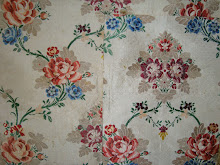





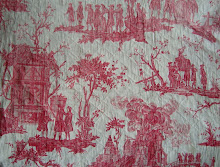
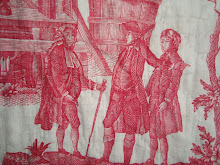




































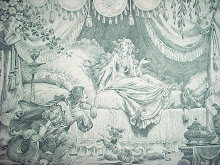







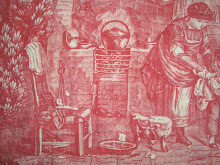





I looked at the photos before reading your piece, Lois, and I agree. The revealed extra scrollwork looks right, and the flowers look the right way up. The jewel looks like the fixing for the hanging decoration with 3 tassels. I think you have a full pattern repeat in your second photo, in both directions of the fabric. Is the greyish-pink area in that photo the reverse of the outside fabric?
ReplyDeleteI have been looking at the orientation of the R&S (definitely strawbs)fabric, and wonder if anything could be deduced from this? Also, with the varying sewing threads, whether (like geological principles) the threads oversewing others would be younger, so giving a sequence of alterations in time?
Fascinating... and heartbreaking, too!
ReplyDeleteI checked out your eBay wares - great stuff!
Cheers,
Michael
This is all so fascinating. Here we are again with the madder dyes. I also liked your ideas regarding the French and their probable method and habit of buying regional textiles. That all makes so much sense. When I get caught up a bit I will send you an email so we can discuss more of this in detail.
ReplyDeleteHello Porcupinetree, I think you are right, we seem to have almost a whole pattern repeat! what luck eh? When I began unpicking the top layers, it looked as if all I would find would be tantalising shreds and tatters inside. The greyish-pink is the reverse of the outer layer of floral twill. I am not sure about the orientation of the R&S layer, I will have a bit of a think, and see if we can expose a wee bit more fabric to see the pattern with a bit more of the stems if poss.
ReplyDeleteI will have to have a close look at the way differeent threads have been used at different stages, perhaps I will look at that in my next post. Many thanks for your valuable contribution! xx
Thanks for your comment Michael, it is fascinating, and a crying shame that the quilt was so damaged, but I was lucky enough to scrounge it from a dealer's rubbish bin, and it is helping us to understand quite a bit about quilting methods, and some of the cultural practises of the time! Best wishes, and please visit again for another post! xx
ReplyDeleteHi Mendofleur, welcome home after your Road Trip. Those madder dyes! there may be some indigo too, I have seen a scrap of deep blue cloth peeping through, this needs a bit more investigation! Anything you can tell us about madder dyes and dye practises would be most welcome! I look forward to a longer e-chat at some point, xx
ReplyDelete